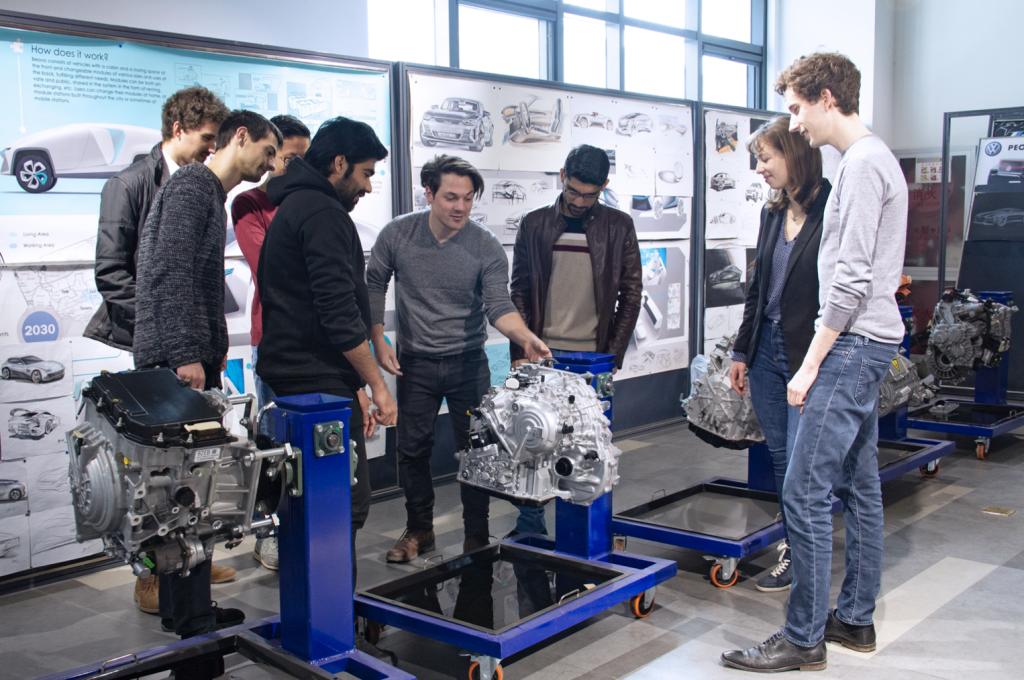By Farah Mubarak, Ke Du, Meixi Duan, Roger Fu and Sewon Lee
From global giants attempting to establish their dominance to emerging domestic brands armed with cutting-edge technology, automotive manufacturers are trying to navigate the fiercely competitive world of the Chinese automotive market. As tomorrow’s rivals seek the path forward, they increasingly are looking to the Master’s Program in Vehicle and Mobility at Tsinghua University to identify students who will become leading professionals in both the domestic and global automobile markets.
The inspiration for the current program can be traced back to the birth of Tsinghua’s Department of Mechanical Engineering in 1932. For decades the university educated Chinese students in vehicle and then aircraft engineering. The university opened up a graduate program in English in 2006 to give international students an opportunity to learn in a cross-cultural environment at a university known for fostering innovation. Over the past 15 years the Vehicle and Mobility program has welcomed students from over 50 countries to take part in its two to three-year curriculum alongside students from the Chinese mainland.
“It was my dream to be enrolled in this prestigious institution,” said Muhammad Rehan, who graduated in 2019 and works in the Pakistan Ordnance Factory. “The lab is so advanced in research that it was so hard to meet the pace my fellow researchers were going at.”
The master’s program is particularly attractive to international students because of China’s growing global role in automotive engineering. China’s auto sector, with 9.6% of the worldwide retail sales in 2019, needs to meet the demands for both quantity of products and quality of innovation. Tsinghua’s School of Vehicle and Mobility (SVM), with 13 national awards and brought them millions in research funds in the past two years, is helping to fuel those needs.

Today, the School of Vehicle and Mobility educates its master’s students in the four main fields that have pushed China to becoming a leading power in the automobile industry: the electrification of cars, the transformation of intelligence, network connectivity and sharing, said Caixia Zhang, the coordinator of the program.
“China is moving forward from a big automobile country to a great automobile power,” Zhang said. “And Chinese automobile companies are going to the world.”
The automobile industry is experiencing a technological revolution, she said. Zhang believes that the program plays a major role in cultivating students’ skills in the modern advancements of the automobile industry.
“We have laid out our projects in two important areas,” Zhang said. “One is new energy vehicles, and the other is intelligent connected vehicles.”
Chen Bao Jun, a 25-year-old Malaysian student currently enrolled in the program, is one of the students doing research in the autonomy of intelligent connected vehicles. Her journey at Tsinghua University started before enrolling in the master’s program. She pursued her undergraduate studies at Tsinghua’s Department of Mechanical Engineering, but her admiration for the School of Vehicle and Mobility encouraged her to remain.
“I could see how the technology expands in the Chinese industry and at the same time study with students from different countries,” Jun said. “It’s more like trying to get the best of both sides.”
Jun is part of the Autonomous Formula Student Team at Tsinghua University. This gives her the opportunity to work with both Chinese and international students. They are responsible for turning an electric racecar into an autonomous racecar.
Autonomous vehicles are “self-driving” or “driverless” vehicles. The automation systems used in intelligent connected vehicles are divided into six levels depending on the need for human driver assistance. It ranges from Level 0, with no automation at all, to Level 5, with full automation and no need for a human driver.
Jun compared the different systems used in autonomous driving to different parts of the human body. Each system represents a certain part.
“The perspective system is like the eyes and ears of the car,” she said. “And then there’s the decision system, which is like the brain. There’s also the control system to carry out the commands made by the decision system to let the car drive autonomously.”
Guo Kun Fang, an SVM graduate from Canada who graduated in 2019 and works at HiRain Technologies in Beijing, believes that it may be difficult to achieve level five of full automation, but it is “crucial for China” if it wants to dominate this industry globally.
“The whole market is booming,” she said. “I think that China has this huge opportunity to get involved in this market.”
Over the past five to 10 years, the SVM has actively carried out global scientific research cooperation and established a first-class international cooperation platform, Zhang said.

The program has established a “U.S.-China Clean Vehicle Collaboration” and initiated more than five international joint research centers with well- known automobile companies in the world. Among them:
• Tsinghua Daimler (Mercedes) Joint Research Center for Sustainable Transportation: Together with Daimler’s R&D experts in China, the center focuses on research in the fields of automated driving and intelligent mobility with joint education and research internship projects that aims on providing sustainable and innovative solutions that meet China’s specific traffic flow needs.
• Toyota Joint Research Center for AI technology of Automated Vehicles: Recently established in 2019, the joint research center is working together to push our current understanding of artificial intelligence’s current impacts on mobility and develop future applications for it in transportation.
• Tsinghua University-Nissan Joint Research Center for Intelligent Mobility: Chasing the tremendous demand for intelligent vehicles in China, the collaboration between Tsinghua and Nissan works to advance the development of electric vehicles and autonomous-drive technologies for the market. The research framework includes battery safety, autonomous driving technology and solutions for the traffic system in China.
• Shell Joint Research Center for Cleaner Mobility: With higher demands for environmentally friendly solutions, the joint center focuses on developing a cleaner use of conventional fuels, and the development of new energies that will reduce greenhouse gas emissions.
“This high level of international cooperation, on the one hand, has broadened our horizons and promoted the development of our discipline,” Zhang said. “On the other hand, it has also won us a good international reputation.”
The English Master’s Program in Vehicle and Mobility is not for everyone. Spots are limited and reserved for tech-savvy students who are dissatisfied with the ordinary and see opportunity in challenges. The program accepts fewer than 10 international students every year and requires an intense year of courses alongside the best students in China. All of the program’s courses are conducted in English, but international students can also take elective courses if their Chinese is good enough.
The result is an intense but rewarding educational experience.
“The program had a variety of courses that was way above my expectations,” said Christopher Spettmann, a German student who is doing research in the development electric batteries.
The program’s prestige and its high-quality student body has placed the university in a leading position in research on new energy vehicles and intelligent connected vehicles. These Tsinghua students are highly sought after in the job market because of the insatiable global demand for skilled international talents with a hunger for innovation.
“To my understanding, China, and especially Tsinghua University, is playing a great role in autonomous driving research,” said SVM student Rehan. “We may not want to admit it yet, but the rise of China to the top ranks of global scientific achievement is now a historical fact.”

Video link for more: https://cloud.tsinghua.edu.cn/d/60184350b9b1498a8997/

